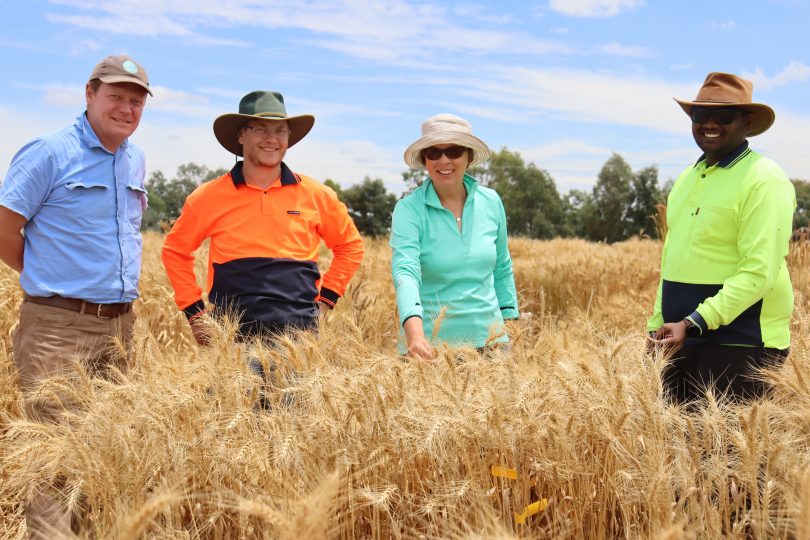
From left: Stuart Brown, Todd Collins, Ejorg Sherman and Aswin Singaram Natarajan stand by a wheat plot at Boorowa Agricultural Research Station. Photo: Hannah Sparks.
A year since CSIRO opened an $11.5 million facility in Boorowa, in the NSW Hilltops Region, researchers are gaining ground with an original trial that aims to help farmers predict crop yields.
This is the first project in Australia to use consumer-grade cameras to measure the height of a plant and the amount of grain in a spike to give a yield estimate that also factors in weather conditions.
The team at Boorowa Agricultural Research Station (BARS), with the Science and Industry Endowment Fund, have already programmed cameras to count the number of spikes in plots of mostly wheat, but also some oats and barley.
Researcher Aswin Singaram Natarajan told Region Media they are using affordable cameras such as GoPros to take the manual labour out of measuring crops for farmers and other researchers.
“In agriculture research, a lot of the processes are manual and we want to understand why a plant is yielding high or low, short or tall,” he said.
“Genetics are hard to humanly measure so what we do is measure traits – the things we can see or feel. One of those traits is height, which allows us to say a plant is tall or short, but it takes time when measuring thousands and thousands of varieties.
“What we are trying to do is teach cameras that are available to everyone to recognise those traits and produce trait estimates, such as the amount of grain in a spike, the amount of spikes on a plant or the amount of plants in a plot. Then we can use that information to feed into a model with the weather to create a yield estimate.”
Aswin said it took the team many attempts to program the camera to measure just the plant’s spike. The reality of projects such as this is that researchers can spend hundreds of hours out in the field before any milestones are achieved.
The wheat, oats and barley were planted in June 2020 and ready to harvest from November, which also means Aswin and research project officers Todd Collins and Ejorg Sherman are working in the heat and with many flies.
However, their commitment will pay off for farmers, said Todd.
“The challenges we’re experiencing in this project are the challenges we’re hoping to eliminate for farmers – physically having to get on our hands and knees to cut off every plant and take it back to the lab to do all the measurements,” he said. “It’s very labour intensive and we do a lot of it at the plant’s maturity, which means December when things are getting hot.”
BARS is a purpose-built, 290-hectare facility that opened on 9 November, 2019, to help develop Australian farms of the future by testing emerging technologies in crop science, agronomy and farming systems.
It will eventually replace CSIRO’s Ginninderra Experimental Station, which was established just outside of Canberra in 1958.

The $11.5 million Boorowa Agricultural Research Station. Photo: File.
Around 2000 sheep remain at the Ginninderra station to ensure the paddocks are grazed ahead of the fire season. However, those sheep will eventually move to Boorowa.
BARS now has four full-time staff and will have five from next year, led by manager Stuart Brown.
During the past 12 months, Stuart and his team have been getting the station ready for future research projects by establishing wildlife corridors and fencing off paddocks.
As well as wheat and canola trials, the station has also completed a trial planting of vetch and using drones to spray weeds.
Next year, the Boorowa station hopes to rotate plantings of wheat and canola, where grazing, potentially more legumes such as chickpeas, and sustainable farming techniques will be introduced to test how the soil responds and find out the best time to harvest using soil probes and temperature and humidity sensors.
This research will allow BARS to assist CSIRO to deliver on its commitment to increase food production in cropping and livestock systems; improve drought tolerance and disease resistance; and improve nutritional values to meet challenges of the future.
Original Article published by Hannah Sparks on About Regional.












